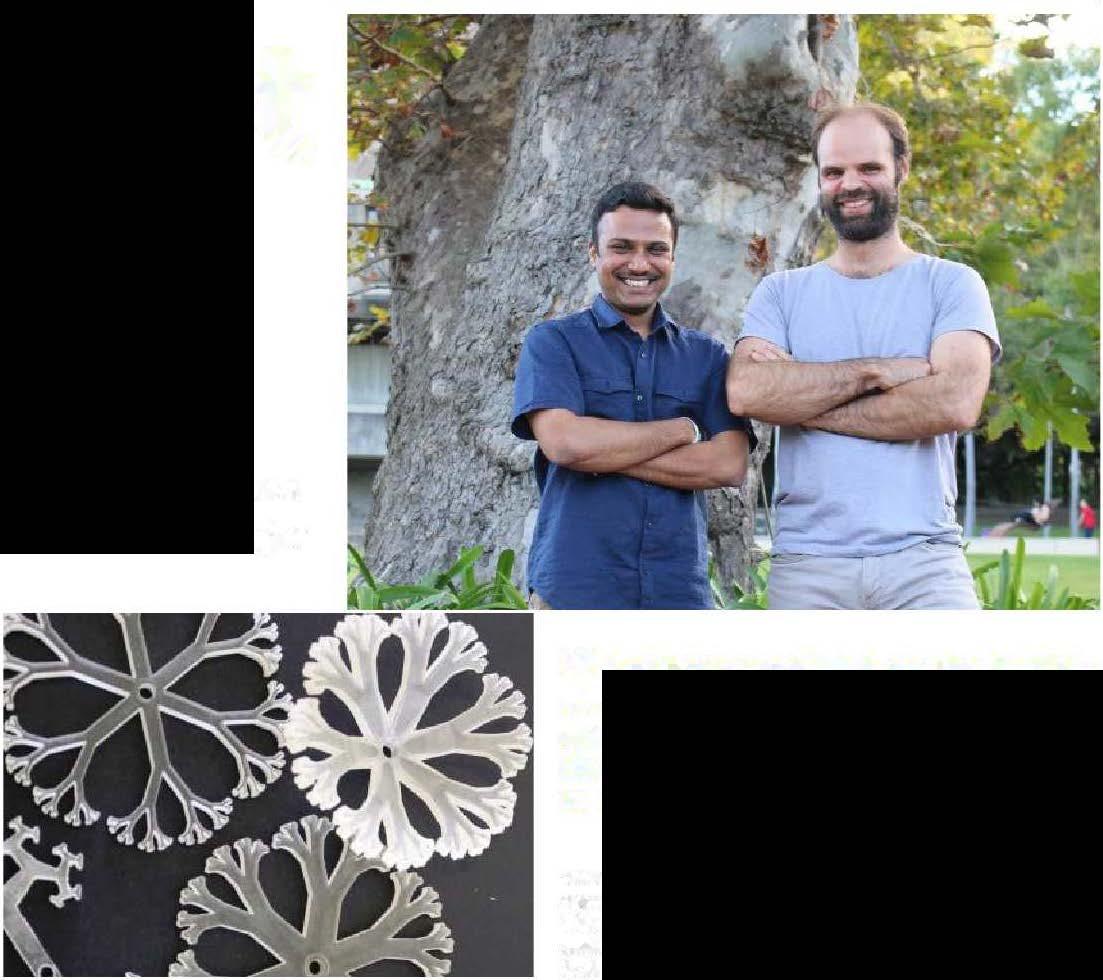
1 minute read
Treeroot sha ed anc ors
from 2016-06 Brisbane
by Indian Link
In an engineering breakthrough, researchers discovertree root-like structures are stronger than traditional anchors
BY USHA RAMANUJAM ARVIND
arure's skyscrapershaveJong intrigued geotechniqueexpert DrPierre Rognon, particularly the innatecapacity of trees to stay anchoredthrough varying weatherpatternsandi.ndiverse soil systems.
Takinginspiration from the efficacy of its complexrootsystem,DrRognonis leadingaworld-firstSydneyUniversitystudy on thepullour capacity of treeroot-like anchorsfor applications ind1efield of civil engineering.
Withaninterest in soil srabiliry,structural dynamics and earthquakeengineering, IndianresearcherShivakumarAtbani,who sharesDrRognon's fascination fortree roots,has recently joinedd1estudy.
Preliminary investigations at theSchool of Civil Engineering'sparticlesand grains laboratory revealroot-like strucrurescould providegreater stabilitywhilealso being morecost effective to produce.
The researchers have foundd1at anchors modelled onthefractal-shapedroots of trees required muchless material to build, making them morecost-effective compared to traditionalshaped anchors.
Their findingswill havefarreaching implications for me constructionindustrr.
Transmissiontowers,offshoreoil rigs utility poles, submerged pipelines aswell as tunnels,whichare highly dependent on effective soil anchoringstrategiescould be mademorestablewith fractal-shapedroot strucrures.
"The quality of anchoringischaracterised by me pull-out capacity,FO,whichis me maximum tensileforce ananchorcan sustainbefore moving upward," said Dr Rognon,whoseresearch aims to predict conditions nnderwhichsoil moves, including landslides or avalanches.
"\'i/e are me first to produce d1etreeroot designand hopeto useour knowledge coconvert me concept into engineering solutions.Wehavealreadyworkedout several models to predict the pull-out capaciry of shallowanchorsin granular soils The next step is to assess the effectiveness of differentfractal geometries when used invariousshallowdepths inthe soil,"hetoldTndia11Link.
"Pull-our capacity is governed by the weight of me soilthatwould be mobilised
,, Anchors modelled on the fractalshapedroots oftrees required much less material to build, making them more cost-effective compared to traditional shaped anchors ,, when tl1eanchor moves upward. Thisiswhy even small trees planted inshallowsoilcan be very difficult to uproot wimout the proper equipment,"Dr Rognon explained.
LikeRognon,Ad1ani developed a love for gardening as a schoolboy. His grandmother, aschoolteacher in Hattaragi, wasa tower of inspiration.
"Naturehasso many tlungswhichwecan explore,"saidArna.tu,whohasaBachelor of CivilEngineering from theBasaveshvara EngineeringCoUege,Bagalkoc and a Master ofTechnology (SoilMechat1.ics and FoundationEngineering) from me SV National Instirute of TechnologySurat.
"Trees area great exampleof adapting to adverseconditions likewindloading. If you examine treerootscarefully,you will observe thatthoseon awindwardside develop deeply and profusely,offering natural resistance.Likewise, in sloping terrain,roots are strongerwheresoil is naturallyweak.'i,'.qhat fascinated mewas, though theroots of smallplants arenot deep, sometimes itwas very hardtopull mem outandweneeded thehelp of some tools ro uprootit complete.ly,"headded. lncorporatingbranchingandtortuosity, the study isclosely lookingat,vays ro improve anchorcapacities by integrating novel strategieswim numerical modelling.
Accordingto thePhDstudent,part of me breakthroughinbiomimicry comeswith realisingmatsoilis not concrete.
"Rootsarenor homogeneous like steel. Sometimes soil canhold me trees very firmly andcan offer enormousresistance for uplift,"Athani said.
"\'Ylealsowant toformerexplore design options and understandwhy somedesign shapeswork bener tooptimise ourresults," DrRognonclarified.Three-dimensional printing,currently unsustainablebecauseof operationalcosts,isalso in hissights
Meanwhile,DrRognon's teamisworking with industry partnerAnchoringRopeand RiggingPtyLtd to develop uniqueanchors forgeorechnical applications.
"Researchin mis area of construction is vital to providinginnovative solutions andwearedelighted to havecommenced workingwid1 d1eUniversity of Sydney civil engineers," a spokespersonfor thecompany said.









